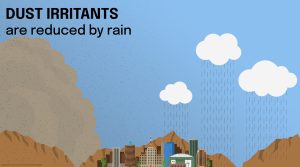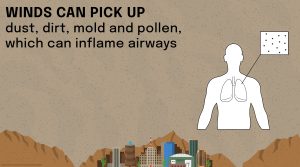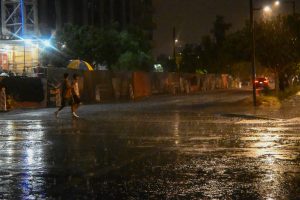- Slug: BC-CNS-Summer Asthma Monsoon. 675 words.
- 2 photos, 2 illustrations available (thumbnails, captions below).
By Lauren De Young
Cronkite News
PHOENIX – A dust and rain storm rolled through the Valley Sunday night, building on a slow but thundering start to Arizona’s monsoon season. While some may look forward to the monsoon season, as the storms bring lower temperatures, those with asthma prepare for discomfort and distress.
During the Arizona monsoon, a weather season that typically lasts from June through September, thunderstorms and heavy rains pummel the state. These thunderstorms mix a “perfect recipe” that spells trouble for asthmatics, according to Dr. Janna Assar, a Banner Health family medicine physician.
“Pollen grains are typically large, and we can’t really inhale them,” she said. The lightning in thunderstorms, though, can rupture the pollen grains, “which then makes these smaller pollen grains the right size to be inhaled and get into our bronchial tree of our lungs, resulting in those asthma attacks and symptoms with patients with allergies.”
According to the Center for the Future of Arizona, about 10% of Arizonans have asthma, a chronic respiratory condition that affects the airways. During an asthma flare-up, the airways become inflamed, allowing less air into the lungs. Flare-ups can be triggered by particulates in the air like dust, pollen and other allergens.
Even worse for asthmatics are the dust storms that accompany monsoon weather. As thunderstorms develop, a strong downdraft can precede the precipitation. When these winds hit and spread across the ground, they can pick up loose dirt and sand and create a formidable wall of dust, called a haboob. Precipitation may follow, which washes the dust from the atmosphere, but if rain doesn’t occur, dust hangs in the air, becoming a chronic irritant for asthmatics.
“If we don’t get a thunderstorm and instead we get that dust storm and we don’t get any rain after, then we’ve got that dust hanging out in the atmosphere, and that becomes problematic,” said Erinanne Saffell, Arizona’s state climatologist.
Along with dust and dirt, the intense winds can pick up particulates, like mold and pollen.
“When an asthmatic person breathes in that dust, that dust also has a lot of pollens in it,” said Barbara Burkholder, a public health consultant and board member of the Arizona Asthma Coalition. “It could have mold or fungi in it, and that can trigger really serious asthma attacks.”
The single best thing a person with asthma can do is stay inside when it gets dusty. But for those who work, staying indoors all day might not be an option.
“When it’s hard to breathe, it’s hard to go to work,” said Amy Singley, 62, who was diagnosed with asthma over 30 years ago. “I would just take my medicine and go drink a lot of coffee.”
Some studies have shown caffeine may provide some relief, and switching to a stronger medication for the monsoon season is another way to keep symptoms at bay.
“I went from one level of asthma medicine to another,” Singley said, noting though the monsoon season was the catalyst, she is still using the stronger medication.
Making the switch to a steroid inhaler, meant to prevent rather than treat asthma attacks, for the monsoon season is something Assar would like to see patients do more.
“If you were really to ask them, they probably are using the rescue inhaler more often, but they don’t usually come out right and tell their providers that,” she said. “That’s not really helping the providers to kind of assess and give them that steroid inhaler if they really need it … to help keep your asthma at bay and well controlled, so that you’re not kind of predisposing yourself to one of these monsoon attacks.”
If a dust storm sneaks up, Assar urged those with asthma and other respiratory problems to “get indoors as quick as possible, and then (stay) indoors until it has passed.”
Experts also recommend watching the weather to ensure you are inside during the duration of the storm. Other suggestions include having an asthma action plan with your primary care provider, keeping an inhaler with you at all times, cleaning out your vents regularly, and using an air purifier.
Those in Maricopa County can sign up for daily air quality alerts.



